Everybody these days wants high performers. Everybody wants to be a high performer. Everybody wants to hire high performers. High-performance is commonly defined as: better, faster and more efficient than others. What this definition doesn’t tell you, of course, is how to do that. I can’t tell you that either, but I can tell you that high quality outcomes and high productivity share a common arch enemy: interruptions. As Aristotle put it so eloquently more than twenty-four centuries ago: The greatest threat to the state is not faction, but distraction.
In my last article, I shared my introduction into the field of interruption research. This time I want to share some fundamental “why” questions that have been bothering me ever since. I like to understand cause and effect. Given that our understanding of all things relating to the human brain are limited by our current knowledge and insight, there is a lot of room for interpretation. So I will interpret.
Let’s start with the most fundamental “why”-question in that context:
Why Are Interruptions Disruptive?
Imagine yourself in front of a whiteboard. You are thinking about an intricate problem. Maybe a complicated engineering task. Or your upcoming wedding. Or your next tax return. Over the last hour you painstakingly added bits and pieces of information to the board with arrows of relations drawn in between them. A bigger picture finally starts to emerge. You know the solution will present itself anytime now. Then someone in a hat steps up next to you. He smiles politely – and erases half your board in the blink of an eye. Before you can even voice your outrage he quickly fills the empty half with entirely different information that hardly makes any sense to you. While he does that, he even smears the remaining picture that you have so scrupulously drawn over the last hour. Finally, to add insult to injury, he tips his hat and vanishes.

Rude! How could he? The whole hour is lost! Why would he do that? Well, he would not. Normally. Social norms would likely prevent anyone, save for borderline sociopaths, from such shenanigans. Hat or no. By the way: the whiteboard metaphor is not from me. I heard it first from the brilliant Professor Gloria Mark and it stuck with me. Anyway, what happens when you remove the clearly visible whiteboard from the storyline?
Consider a scenario in which you are equally concentrated on solving whatever you are focused on. Only instead of offloading your contemplations externally, on a whiteboard, you are keeping everything in your head. This is not entirely unheard of. You are doing this all the time. Everybody is. This inner, figurative whiteboard is called a Mental Model. When I first read about this, as a software engineer I immediately thought of program state. Whatever the name, it is a representation that your brain creates of the outer world, specifically of the thing that you are focused on. This representation is constantly updated by all the new information and relations you think of and learn about.

Now, what happens then when you are interrupted? Altman & Trafton 2002 described the Memory for Goals Model that is widely cited and referred to when pondering this particular question. The short answer is: pretty much the same will occur in your head as did to the whiteboard when the guy in the hat came along – vandalism. Whether your mental model is just maimed or wholly destroyed depends on many of the factors described in my previous article. However, two factors peek out: similarity and complexity (Cades, Werner, Trafton, Monk 2008). The closer the new, interrupting thing is to what you were already doing, the better it will fit into the existing Mental Model in your head. Ideally, it is not different at all. That means you can keep using the same model – give or take a few pieces. The further away the new thing is from the old, the more different the Mental Model that presents itself. If the two things are entirely different, then the two models will have no overlap at all.
As an example, let me tell you a short story that you may have experienced as well: For the last twenty minutes you have investigated your fridge and your pantry and a lip-smacking meal is starting to form in your mind from what you found. While you are not hangry yet, you are certainly on the verge of really hungry and the prospect of the nice, home-cooked meal makes your mouth water. Then your partner comes in, bright eyed and bushy tailed about a new idea! In the beginning, you listen with half a mind, while still thinking about what goes into the dinner you were about to start making. As your partner’s telling goes on, and is indeed very interesting, your thoughts move ever away from culinary delights and you get drawn into the story. An undetermined time later, you find yourself sitting at the kitchen table with a growling stomach - and order in Szechuan food. While that is delicious, that was not your plan. Your own Mental Model of the dinner has evaporated without you being consciously aware of that. It was replaced by the tale your partner spun – or more precisely: it was replaced by the entirely different, non-overlapping Mental Model that this tale induced in your mind. Also, you can figure yourself what my usual role is in that recurring epic.

From that anecdote I want you to take one thing: Complexity of the interrupting thing matters! Complexity refers here to how many details and relations it contains. The more complex the thing is, the more space it will occupy in your head. The whiteboard metaphor fits yet again: more details and relations drawn require more space. At some point, the whiteboard would simply fill up and the only way to add more would be by first erasing something else. And this is pretty much what happens with the Mental Model as well: If the new, interrupting thing requires more space than there is available then it will push out the old. Your old model collapses – partially or fully. The amount of available space, which is referred to as Working Memory Capacity, varies from person to person (Forgoughi, Malihi, Boehm-Davis 2016) and there is good indication that you can train to grow it (Dingfelder 2005). However, it always will be finite. It also always will be smaller than truly complex problems, hence you will still need to simplify them, so they fit in your head, so you can think about them.
But wait, it gets worse: Even if your old Mental Model survives the interruption mostly intact, it will still suffer from what the scientific literature calls Memory Decay. It is as bad as you imagine: the things in your memory rot away over time – unless you keep working with them to keep them fresh in your mind. Here the whiteboard metaphor fails us. The best I can offer up is the image of a news or social media feed: new things are continuously added to the top, ever pushing down the old contents towards the bottom until they leave your field of vision and are gone into the digital aether – unless they are being upvoted by steady interest and stick around. The same happens to the old Mental Model, that you are temporarily not using when working on the new thing. The above mentioned Memory for Goals Model predicts exactly that and many studies found strong evidence that this holds true, Monk, Trafton 2008 makes an especially convincing case.

Once more back to the question: Why are interruptions disrupting? The answer is: because interruptions screw with any existing Mental Model by either overtaking its space or moving away from it temporarily, which leads to its decay.
Unlike in the story with the hat guy messing with your whiteboard, the damage done is not obvious to the outside – nor is it always to the inside – but it is there nonetheless.
Now the question becomes: what are the consequences of that damage? Well, there are a few…
Why Do Interruptions Hurt Productivity?
Let’s go back to the drawing board. Excuse me, the metaphorical whiteboard, I mean. Consider for a moment the effort it takes to create that big picture. When you do it the first time the process of writing and drawing on the board costs time, but compared to the big effort of gathering all that information and relations together the drawing effort is small. When the guy in the hat brazenly erased the board and left, and you later had to redraw half of it from scratch, you would likely have been faster than the first time around. You would recall some of the things that were on the board and you would remember the source of where you found others. This means retracing your steps would be quicker than initially finding the pathways. Either way, it still would take you time and effort.

The exact same goes for a mental picture. In research papers you find this most often as Resumption Lag, rarer as Reimmersion Time (Tregubov, Boehm, Rodchenko 2017) or earlier Reorientation Time (Burmistrov, Leonova 2001). It is the time measured after the interruption has finished and before the interrupted task is resumed again. Meaning: it is the time it takes to rebuild the Mental Model.
You have certainly experienced Resumption Lag many times over. Think back to a time when you were intensely focused on a complicated task and the world around you faded into a distant murmur. Then, suddenly, something comes cutting into your thought process like a knife, ripping you out of your concentration with the same abruptness as a cold bucket of ice water poured on your head would have. Being so deeply immersed into the topic means that you did build an elaborate and, in all likelihood, fragile model in your mind. That model is now shattered into pieces. That certainly hurts in the moment and it will hurt again when whatever disrupted you has been dealt with and you have to pick up all those pieces and rebuild the picture in your mind to continue. This costs time. This is error prone (I’ll get back to that in a bit). It is certainly not efficient.
To make it painfully clear, here is some math: consider a 60 minute task. It is interrupted three times. Each time it takes 5 minutes to think back into it. That means the total task time is: 60 + (3 * 5) = 75 minutes. In productivity terms: instead of one task per hour this is only 60 / 75 = 0.8 tasks per hour. A 20% reduction in outcome performance.
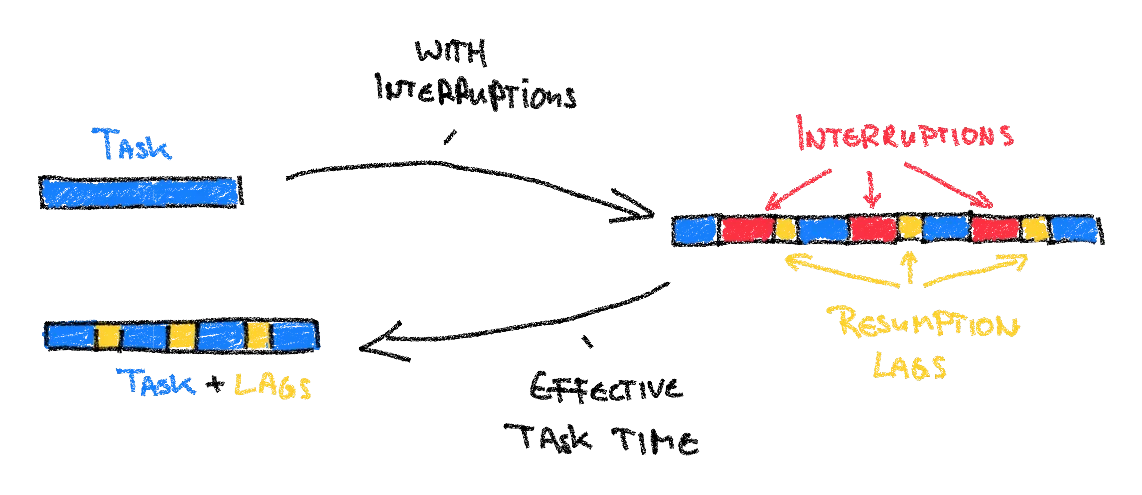
With that it becomes pretty obvious how interruptions hurt productivity: less is getting done in the same time.
How bad is it? Magrabi, Li, Day, Coiera 2010 showed it depends on the complexity of the interrupted task. Interruptions resulting from switching in between tasks from more than one project can eat up 20% of your time, according to Tregubov, Boehm, Rodchenko 2017. That is a full day out of a five day workweek! Iqbal, Horvitz 2007 found in their study at Microsoft that an interruption by half an hour of conversation on average leads to a subsequent resumption time of another half hour to resume the task (compared to a five minute conversation that results in an average of fifteen minutes of resumption time).
Why Do Interruptions Increase Error Rate?
I’ve already hinted towards the first reason: the Resumption Lag is caused by you having to rebuild the Mental Model from an either decayed or otherwise partially destructed state. As it turns out: nobody is perfect. That means you will make mistakes in the process of rebuilding the model. Once a mistake is made, it will have ripple effects that of course will impact the outcome: it is faulty, flawed, buggy, corrupted. Take your pick. Altman, Trafton 2008 showed an up to three times higher error rate resulting from short (five second) interruptions.
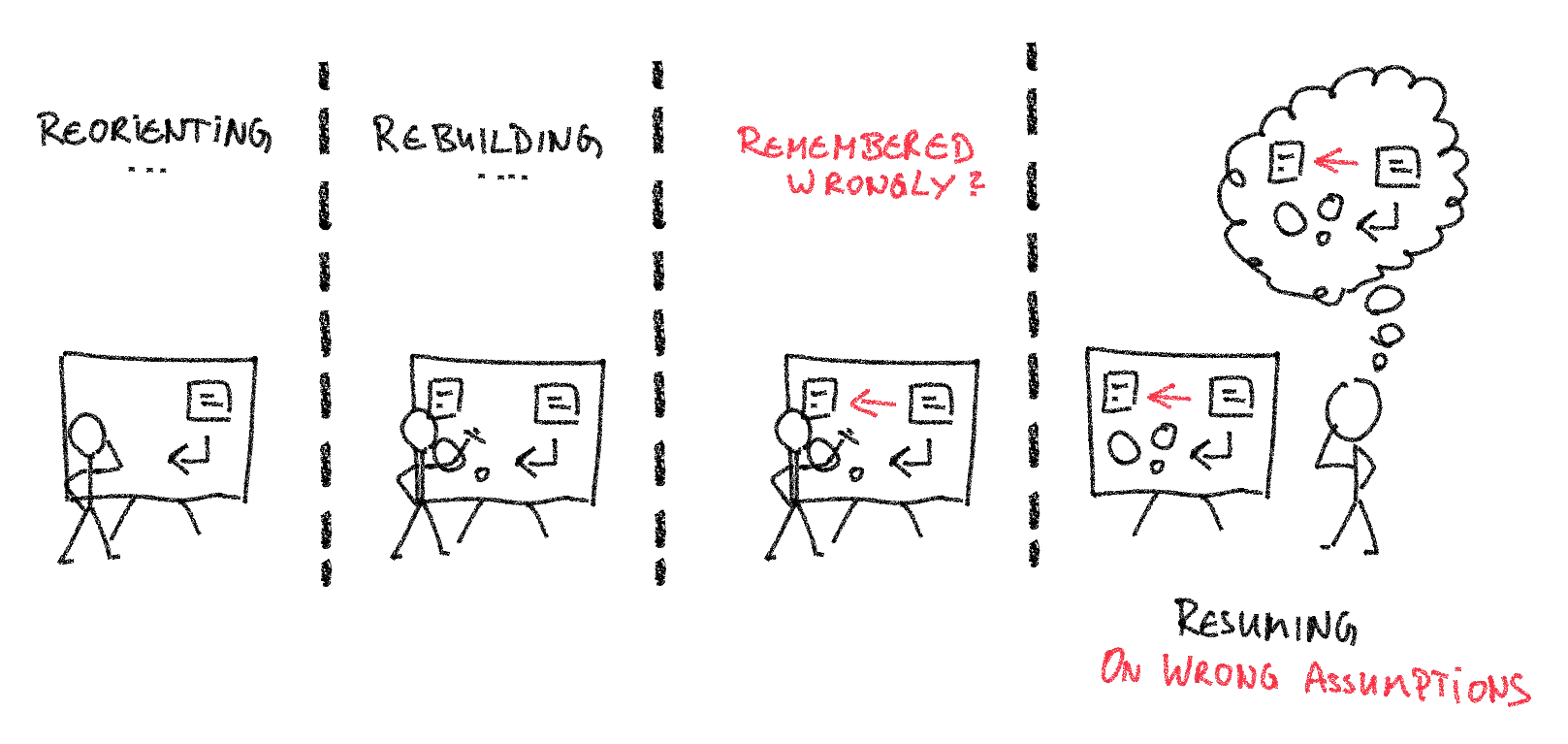
There is more.
Using again the handy whiteboard metaphor as it can explain another observed mechanism that research has described: If you have ever cleaned up a physical whiteboard after using it you certainly have found out that erasing your drawings does not work perfectly. It’s a bit of a pain, to be frank. Working with others in shared office spaces I have often come into a room where someone halfheartedly cleaned the board, leaving behind ghosts and fragments of their musings. I may have been guilty of that as well. Anyway, those remnants of previous artworks can make it hard for you or someone else to separate them from the added layers of your masterwork – and then misunderstandings become mistakes.
Those leftover bits of information are not only an annoyance when you work with physical whiteboards, but they also occur in your Mental Model. The same principle applies: residual fragments from a previous task carry over to the current task and mess with the current Mental Model. Hence the scientific term: Attention Residue, the leaking of information from one Mental Model into another.
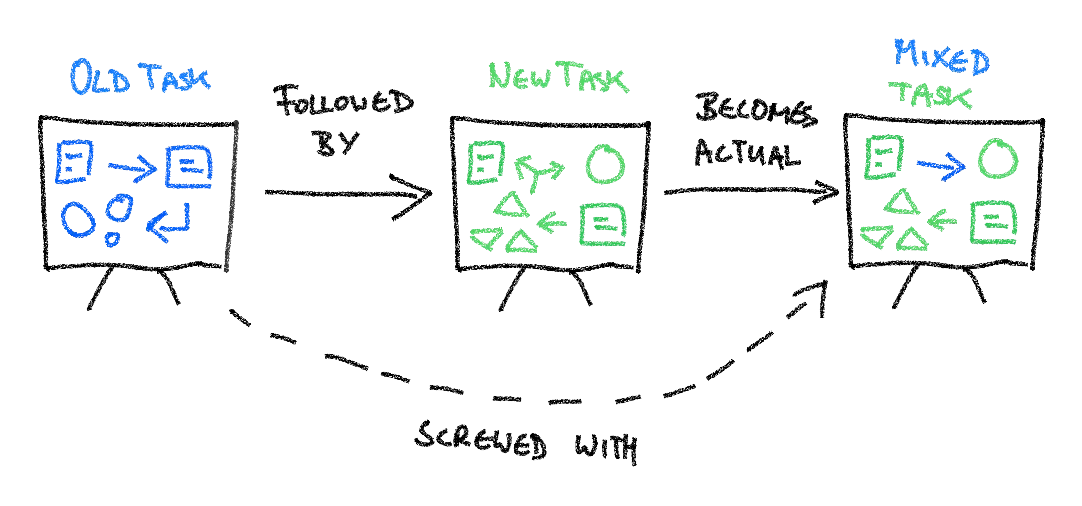
When talking about any outcome of work, you must consider both tasks: The one that was interrupted and the interrupting task. The Attention Residue affects the latter one: the interrupting task, that barges in. Again, you certainly have experienced that as well. Remember the last time you were working on something interesting, something that moved you ahead in your goals, which was interrupted by a time-sensitive chore that had to be done now. This chore may come from the hat guy, or maybe you kept pushing off a bothersome thing until it became urgent. Either way, you will not be fully motivated to do that interfering task and you will keep thinking about the intriguing thing you were forced to suspend. Recall the last time that happened to you. That is a good example of Attention Residue messing with you. Or at least messing with the outcome of your work.
Leroy (2009, 2016), who contributed fundamental research in this area, describes two human needs that underpin the effects of Attention Residue:
- Need for Completion: As long as you do not meet the goal you set out to, you are distracted. This drive also motivates you to finish.
- Need for Cognitive Closure: Even after meeting your goal, you may still fuss about your solution, thinking of alternatives, which distracts you from the next thing.
As long as both of the above needs are not satisfied you will suffer from Attention Residue.
There is also a related effect that has not been named (or I don’t know the name). Think back to the last time you have heard or seen something extreme, as in: something that evokes strong emotions in you. Rather than using yet another horrifying news story, think of something positive: the birth of a niece or nephew or a wedding proposal a close friend of yours received or somesuch. This kind of news persists with you for days. Once embedded, it overlays other things you are thinking about. Within the whiteboard metaphor, I would think of someone writing with a red permanent marker on it. Whatever is then modeled on that whiteboard, there is always that glaring red spot that cannot be erased.
So to the question of why interruptions increase the error rate, the answer is twofold: First there is Attention Residue, that makes you think of not-the-thing-you-are-doing, which makes you prone to make mistakes. Then there is plain imperfection of human memory that causes mistakes when rebuilding a previously interrupted Mental Model. Together they can wreak havoc on the quality of the outcome.
The amount of error rate increase depends on the context and the task. Westbrook, Woods, Rob, Dunsmuir, Day 2010 showed the error rate increases by 12% in medication administration when interrupted - while the severity of the mistakes doubled. In the study Adamczyk, Bailey 2004 it was found that error rates would increase by 25% and according to Bailey, Konstan 2006 the error rate can double as well, depending on the task.
How Can You Stop Interruptions From Diminishing Performance?
The good news is that there are actually a lot of things that can be done. In my opinion the single most important thing is: Create awareness. First for yourself, so that your confidence does not suffer from low performance caused by high interruption amounts. It’s them, not you. Then within the groups you are part of: Make it widely known and clear to anyone that interruptions are a significant factor in productivity, error rate, quality – and anything else pertaining to performance – and finding ways to reduce them is in the best interest of all.
With that in mind, I also want to acknowledge that there are as many situations as there are people around. Please consider my answers and suggestions below with an appended if your circumstances allow.
Lastly, some of the measures I will propose to you only make sense in the context of systems / groups / organizations. I will mark them clearly. Everything else can be done by every individual or group alike.
Let’s get to it then:
Decrease Amount, Frequency And Duration Of Interruptions
I know, if it were that easy, we would not be here talking about the topic. Still, there is a vast gulf between being unhappy about “feeling disrupted all the time” and having an informed discussion about the topic, with the knowledge of the underlying mechanisms and resulting consequences (see the article above).
One way to look at this is from the direction of project management and work organization. In other words: how can you make work (time) better predictable? How can you decrease the amount of unplanned work that comes in? Many books have been written on this topic. The Mythical Man-Month and Making Things Happen come to mind as great starting points.
Everyone:
- Track Interruptions: You need to know the extent of the problem. Sometimes it is just perception. More often it is not. It is always quantifiable. How frequent do interruptions occur? How long do they last? At what times are they most likely to happen? The power of raw numbers that showcase the true scale of the issue cannot be overstated. This alone can turn the tide.
- Be Mindful Of Other People’s Time: “Can I interrupt you for a minute” sounds polite, but it is already an interruption, if maybe a lesser one than the actual item. Do not take anyone’s availability for granted. Model the behavior you want to see. Use asynchronous means (like messengers, mail, ..) with sufficient time ahead to arrange for time. Reduce the amount of interruptions you are causing.
- Set Boundaries On Your Own Time: Do not feel bad about blocking time for concentration. Make that public by sharing your calendar, hanging a sign outside of your door or whatever helps to communicate to others when you do not want to be disturbed. Do not forget to clarify also when you are best available and make an effort to consider other people’s time requirements. Reduce the amount of interruptions and funnel their occurrence (as much as you can) in time that you control.
Organizations:
- Culture Of Respect: Values do not spring into being by happenstance. They are forged intentionally. Valuing each other’s time is a deliberate decision that requires purposeful design of processes. Take the time to think that through and come up with ideas / guidelines that make people aware. Provide tooling that makes it easy to arrange shared time. This will reduce the amount and frequency of interruptions for everyone.
- Culture Of Focus: Find long stretches of time and designate them for concentration. Like meeting-free days each week. Communicate in batches, not continuously. Make it public what you do and encourage everyone to join in. Provide guidance and tooling to make that easy. This reduces the probability of interruptions, by making (many of) them planned events. It also decreases the average impact of interruptions, because most of them should happen outside of dedicated concentration time.
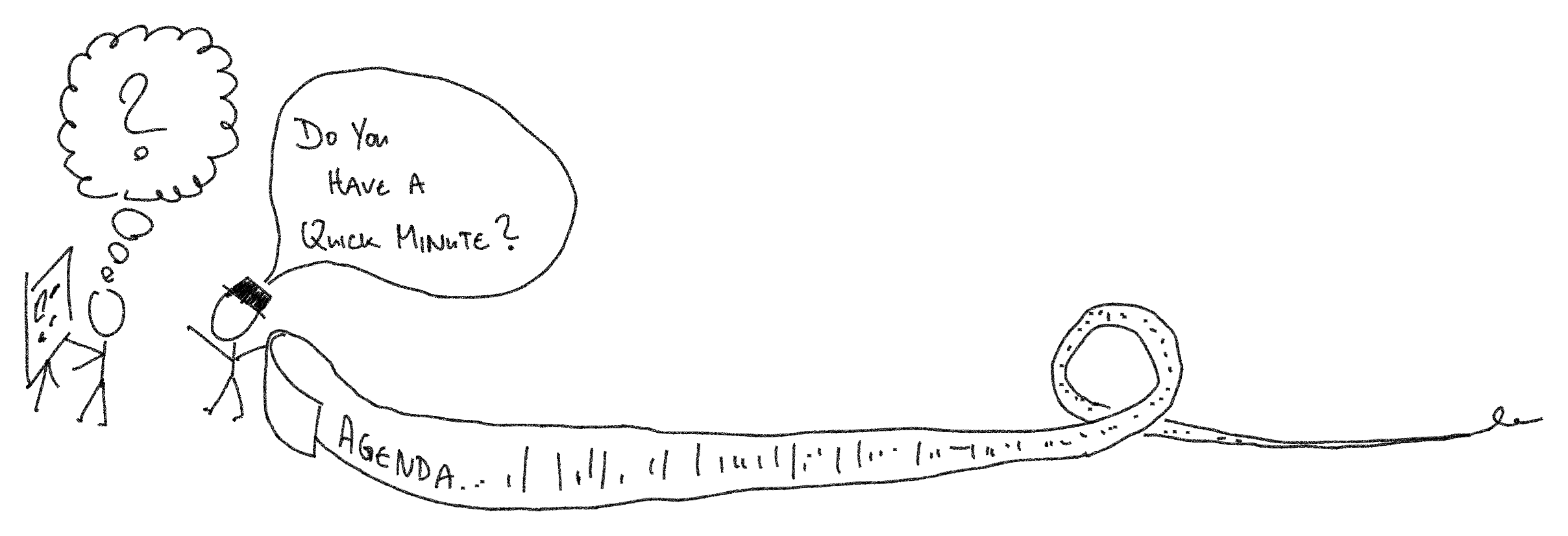
Decrease Task Complexity
The next best thing to reducing interruptions is making your work more resilient to them. The major factor in that is Mental Model complexity, which directly derives from task complexity. In that context, think of complexity as fragility. The more complex your tasks are, the easier they are disturbed, the more costly is the damage to them and the higher the price to rebuild them after the interruption passes (Resumption Lag). You need to have a good understanding of the nature of the tasks that you are engaged in. Combining this with the insight into interruptions, as proposed in the previous topic, will allow you to make good decisions.
Everyone:
- Divide And Conquer: Decompose a given task into two or more similar, but simpler, subtasks. Each simpler task will require a proportional simpler Mental Model. Simpler models require less mental capacity which makes them more resilient towards interruptions by reducing their cost to rebuild.
- Separate Planning And Execution: The complexity of a task is often concentrated in understanding the task and formulating a solution. Still, the execution, the doing part, may take much more time. In such circumstances, assuming that interruptions are not distributed exactly equally (e.g. less random phone calls in early morning), deliberately separating the work into two phases can be extremely helpful. Complex things in the “off hours” and simple things during “prime time”. This reduces the cumulative effect interruptions have, as you steer your most fragile work out of their way.
Organizations:
- Pre-Process, Process, Post-Process: Separate a single workstream of highly complex tasks into multiple workstreams of simple tasks. Complexity at scale has known solutions since the introduction of manufacturing. With less complex tasks across the board, the impact of interruptions is dampened.
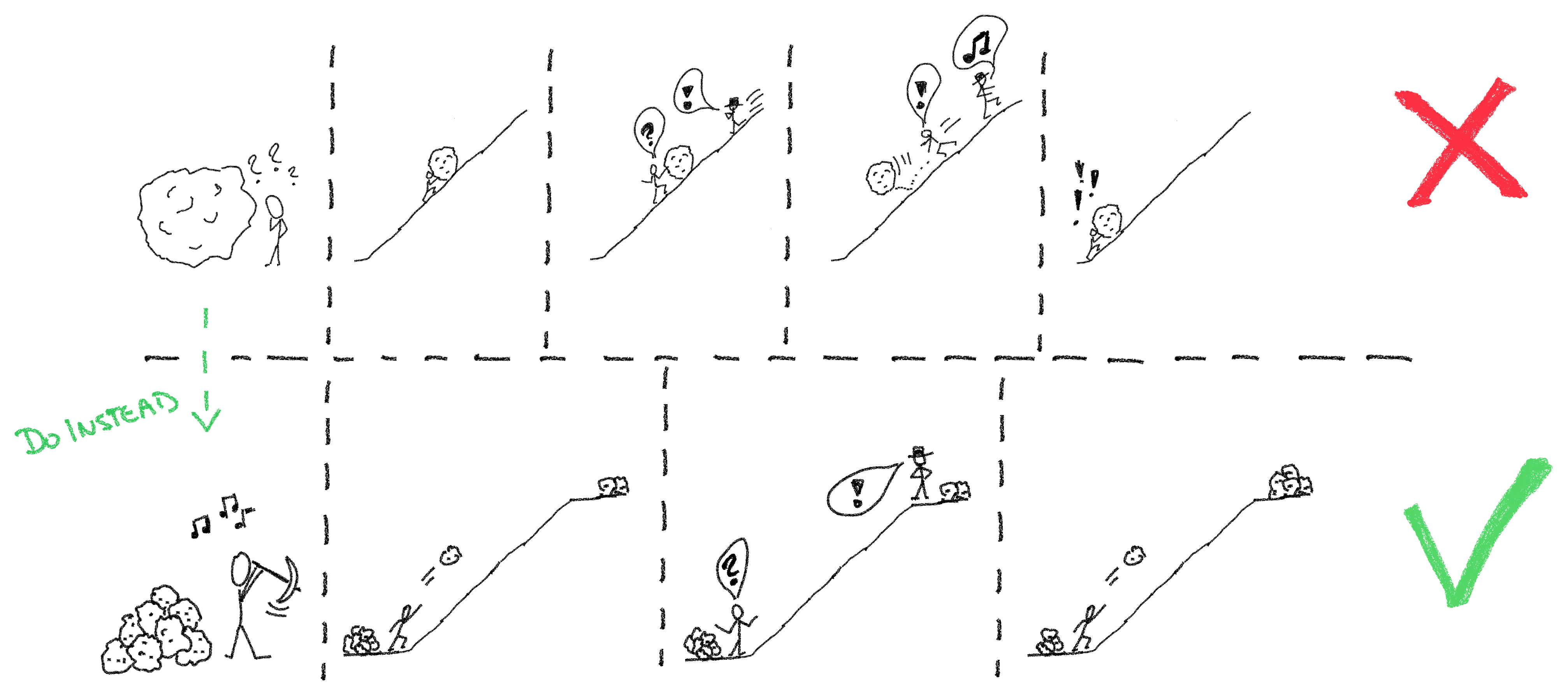
Increase Task Similarity Or Decrease Task Switch Frequency
Regardless of whether the amount of interruptions or the task complexity can be reduced, there is another pathway to reduce the cost of interruptions: Order the tasks by the shape of their Mental Model. That means: make sure that you work on similar tasks first. This way switching between tasks has a lower price, as less changes in the Mental Model are required and more parts of the Mental Model will be continuously used, hence less decay.
This is a project management concern. As Tregubov, Boehm, Rodchenko 2017 showed: you can easily lose a whole day per week just for task switching
Everyone:
- KISS: Stick with one project that you are working on. Within that aim to switch between tasks that translate into closely related Mental Models. Move on to tasks that are at least somewhat similar. This will minimize Resumption Lag - a lot.
- Prepare Then Do: Make it your first task to group all of your tasks on your list by similarity. Only then pick up the first actual task from that list. Abraham Lincoln famously said, “Give me six hours to chop down a tree and I will spend the first four sharpening the axe.” This is a variant of that. This will reduce the amount of Mental Model changes in between tasks solidly.
- Pre-Dedicate Your Time: This is a different way to look at it. Instead of choosing from the list of already existing tasks, make sure that your list is filled only with similar tasks in the first place. For example: Dedicate days to communication, dedicate other days to engineering (or whatever you do) and yet other days to administrative toil. By doing that you limit the range of “task varieties” that make it on your list. Again: Less Resumption Lag for more similar tasks.
Organizations:
- Constrain Number Of Workstreams: This is about distribution of work. Make it a project management / planning goal to optimize for similarity of work. Only comparable work goes into the same workstream. Then constrain the amount of such workstreams that individuals or teams work on during each time frame (e.g. sprint, quarter, etc). Maximizing for similarity minimizes Resumption Lag.

Increase (Work) Experience
You create Mental Models for everything that you do: Working a specific task or driving your car or cooking spaghetti bolognese. Having done something, especially repeatedly, allows you to recall a stored Mental Model for that thing at a much lower cost than creating a new one from scratch. I like to think of this as “higher level (mental) modules”, that I can load and combine. From working with complex systems for half of my life I don’t think this is even limited to repetitive work: having various Mental Models about a certain domain will help with lateral thinking in that space because each model adds perspective.
Mind though: experience does not help to mitigate increasing error rate (Westbrook, Woods, Rob, Dunsmuir, Day 2010), it only decreases the impact on productivity by decreasing the Resumption Lag.
Everyone:
- Extend Your Toolbox: Learn more! Try more! Tinker! Each success gives you a new pathway. Each failure tells you where not to go. All of that will add to the bigger picture, allowing you to draw conclusions and make educated guesses even in areas that you have not experienced directly. It also increases your speed of building Mental Models: many components or even whole subsystems are already known to you. That also means less surface for interruptions to act on, and if they do, it will cost you less time to resume.
Organizations:
- Culture Of Learning: Tenure comes with deepened and broadened domain knowledge - if you foster that, by providing incentives to learn. Time to grow and self-develop should be built into the organization of work. Your goal here is to establish a self-reinforcing feedback loop of self-improvement, so that everyone will have better and more Mental Models accessible. Interruptions will lose much of their punch.
- Blameless Culture: Learning requires experimenting. Experimenting means taking risks and making mistakes. Likely a lot of mistakes. If that has negative consequences for the person that made the mistake – experimenting will seize. In fact it will never start in the first place under such conditions. Experience will stall at low levels and interruptions will have a major impact on the already low productivity. Don’t go there, but instead encourage experimentation. Share learnings – of failures and successes alike. Again: better and more Mental Models for the win.
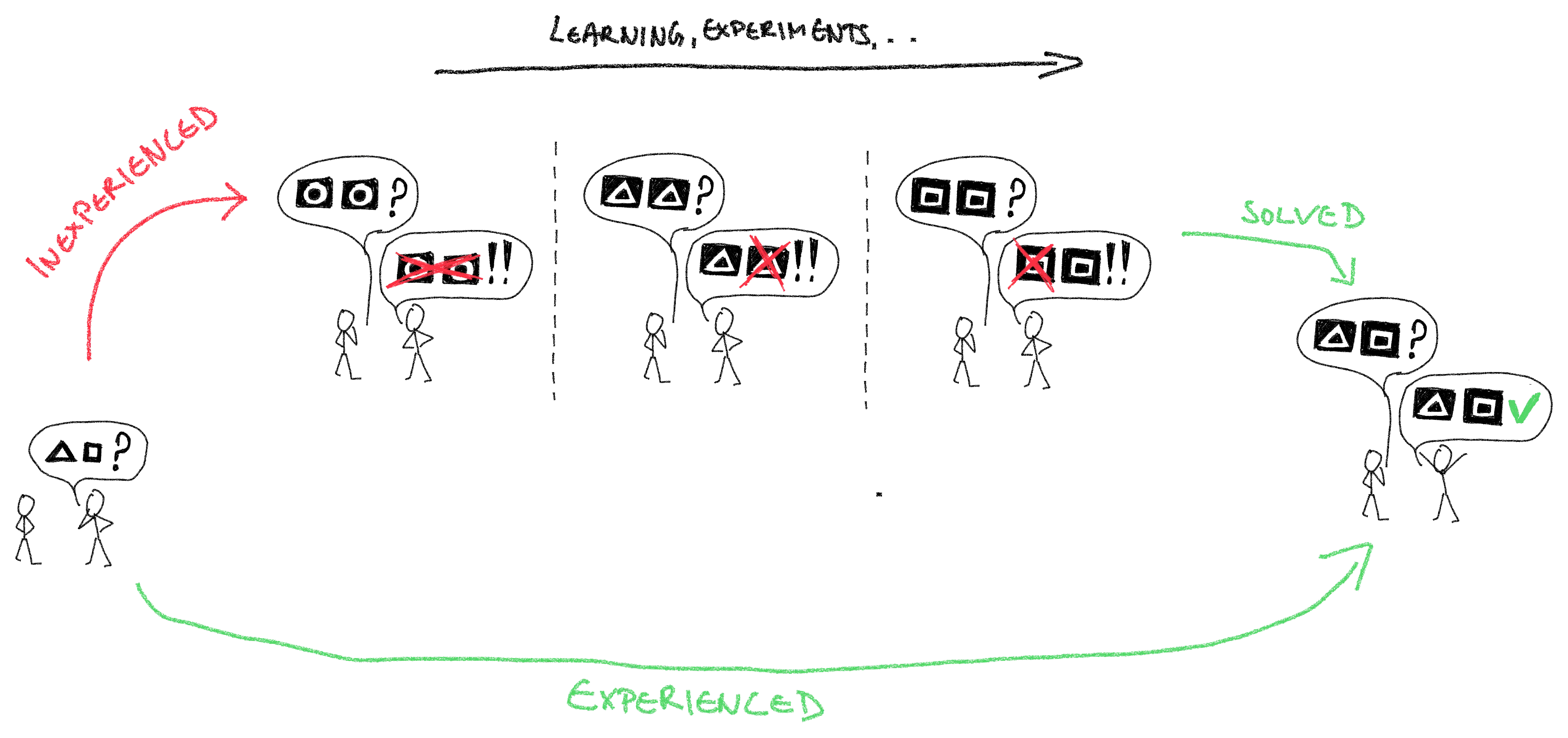
Heighten Pressure, focus on the Negative
This one I found a bit surprising. Leroy 2009 investigated the question of how time pressure relates to Attention Residue. Her research revealed that more time pressure helps you to reduce the Attention Residue. Having “all the time in the world” allows you also to overthink and keep thinking of alternative solutions way after you solved the problem. In Leroy, Schmidt 2016 the question was asked whether aiming to achieve a positive outcome or attempting to prevent a negative outcome helps with moving on from previous tasks. It turns out a negative framing (“What bad thing will happen if I don’t get this done?”) works much better. I figure this relates to the evolutionarily caused Negativity Bias.
Everyone:
- Religiously Timebox (i.e. predesignate a fixed amount of time for) your tasks. Attention Residue comes from the inability to disconnect your thoughts from a past activity. Having a clear boundary will help you to cut the ties to previous thoughts and move on.
- Start With Unfavorable Outcomes: When beginning a new task, remind yourself of what you will lose if you don’t do this. This will make it easier for you to detach from the previous task with reduced Attention Residue. From my other readings I must warn you to approach this with caution. Do not overdo it (e.g. foster a negative mindset). If you do, it will cause stress. Stress will quickly overshadow any positive gains. Use with care!
- Crystal Clear Definition Of Done: The more ambiguity in the goal definition, the more room for you to doubt your solution. Be entirely clear about what is to be achieved and how you measure whether that is the case. Err on the side of greatest possible obviousness, if in doubt.
Organizations:
- Foster Confidence: The last thing you want is everyone questioning their sanity and their solutions. People get stuck in loops from which they cannot move on. Certainly not the most productive state. Bolster confidence by providing positive feedback on executed solutions. Make it easy to move on. Help mitigate Attention Residue.
- Communicate Clearly: Leave no room for misinterpretation. Don’t let anyone waste time questioning their understanding of the task, which would make it that much harder to identify success. Done must be highly obvious and it must be unambiguously clear that no alternative solutions are required or intended.
The right Tooling
As an engineer, this is of course my go-to solution for, well, anything. Pracash, Koczmara, Savage, Trip, Stewart 2013 found (in the medical space) that having supplemental tooling to execute a task can reduce the interruption-caused error rate by half. This means: Understand the task, then make sure you have the right tools to do it in place. Or build them, if they don’t exist.
Everyone:
- Integrate Quality Assurance: Assume you are making mistakes – because you are making mistakes. You want to arrange it so that whatever you did is automatically verified. Like spell-checking when you write a text. In software engineering this means having automatically triggered software testing integrated in your continuous deployment / integration pipeline. I am sure there are comparative and highly specialized solutions in other fields.
- Automate Everything: Automation is usually associated with productivity. However, working mainly with reliability topics professionally I can assure you that error reduction is the silent hero here. Automating a process means that you are now out of the equation. Your state of mind, whether distracted or focussed, is of no relevance anymore towards the outcome of the process. This does not help you reduce a few errors here and there as much as it helps you to eliminate whole classes of errors. I cannot overstate how much automation plays a role in reliability concerns.
Conclusion
You have now created Mental Models of Mental Models in your head. You are welcome for the recursion!
Thanks for following along. I hope you now have a much better understanding of the underlying causes and mechanisms that make even seemingly innocuous interruptions so painful for your own performance. Maybe I even surprised you with one or two insights that will help you to take control of your own time and mental resources again. The Information Age that we are living in comes with many intricate pitfalls and masked dangers that ride on the trail of the vast amount of new opportunities. If I could ask you one thing, then it is this: spread the word! Help to build awareness. While interruptions are a problem as old as humanity itself, technology magnified the size and frequency to an unprecedented level. Dealing with this in a sane way requires cultural change – or we are at peril to lose a battle that we don’t even know we are fighting, likely because we are so distracted through the many interruptions that hinder us from thinking clearly.
This article will not be the end of my research journey, but merely a segue to the closely related Wild West of attention research. Stay tuned.

A note on why I chose to present error rate and productivity as separate proxies for performance: Productivity seems to change the outcome linearly whereas error rate can have an exponential effect. By that I mean: productivity impact is predictable and within a limited range of outcome. Not so for error rate. The range of outcome is in between that of reduced productivity (added time of fixing the mistakes and doing it again) and incalculable catastrophe (consider potential crippling reputation costs or something like the failure in the Mars Climate Orbiter from 1999).
Sources
- Why are attentions disruptive? Why do interruptions decrease productivity? Mental Model, Memory Decay, Resumption Lag
- Burmistrov, Leonova 2001: Interruptions add Reorientation Time => Resumption Lag
- Dingfelder 2005: What influences Working Memory Capacity and how to improve it
- Iqbal, Horvitz 2007: Length of interruption directly correlates with Resumption Time => Memory Decay
- 5 min conversation => avg 15 min after resuming task
- 15-30 min conversation => avg 30 min after resuming task
- Cades, Werner, Trafton, Monk 2008: Complexity of interrupting task increases resumption lag => Complexity requires space
- Monk, Trafton 2008: Longer and more demanding interruptions increase resumption lag => Memory Decay
- Magrabi, Li, Day, Coiera 2010: Resumption Lag strongly correlated to complexity of interrupted task => Memory Decay & Rebuild complexity (com
- Tregubov, Boehm, Rodchenko 2017: More than one project => Switching between tasks between projects => 17% of time goes into switching (Resumption Lag)
- Why do interruptions increase error rate? Attention Residue, Rebuilding Errors
- Adamczyk, Bailey 2004: Interruption causes increased error rate (25%), increased completion time (27%) and doubles the annoyance
- Bailey, Konstan 2006: Error rate doubles when interrupted during primary task
- Altman, Trafton 2008: Shows short interruption strongly increase error rate (5s => 3x higher, 3s => 2x higher)
- Leroy 2009: Attention Residue is caused by focus on previous activity that interferes with current activity. Need for Completion. Need for Closure.
- 40+% better performance in ideal conditions (able to finish + time pressure)
- Westbrook, Woods, Rob, Dunsmuir, Day 2010: interruptions in medication administration => 12% increase when interrupted & severity doubled
- No mitigation through nurses experience level
- Foroughi, Werner, Nelson, Boehm-Davis 2013: Interruptions decrease outcome quality, measured in rated essays => creative work badly impacted
- 17% worse scores for interrupted vs not
- 11% less words
- Pracash, Koczmara, Savage, Trip, Stewart 2013: Appropriate tooling can cut down error rate by half
- Leroy, Schmidt 2016: Regulatory Focus Theory => when focused on avoiding negative outcome Attention Residue lower than when focused on achieving positive outcome
- Forgoughi, Malihi, Boehm-Davis 2016: The higher Working Memory Capacity, the lower error rate following interruptions
If you want to join a discussion, please visit the cross-published version on LinkedIn.


